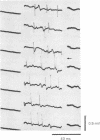Abstract
Fibrillation potentials in normal muscle are identical in origin with the 'spikes' in the endplate zone. The difference in shape is due to the site of the electrode. Both potential types are characterised by a high average maximal frequency and a very irregular discharge pattern. These properties distinguish them from the typical fibrillation potentials of the denervated muscle which show lower maximal discharge frequency, very small differences between consecutive time intervals, and slow up and down drifts in the discharge frequency. Less commonly, irregularly discharging fibrillation potentials are also observed in denervated muscle, which are exactly the same as those in the normal muscle, and which, therefore, may be assumed to have the same origin. It is only the rhythmically discharging fibrillation potentials which indicate a denervating process. The irregular fibrillation potentials, on the other hand, are of no pathological significance. The term benign fibrillation potentials is suggested for the latter.
Full text
PDF



Images in this article
Selected References
These references are in PubMed. This may not be the complete list of references from this article.
- Belmar J., Eyzaguirre C. Pacemaker site of fibrillation potentials in denervated mammmalian muscle. J Neurophysiol. 1966 May;29(3):425–441. doi: 10.1152/jn.1966.29.3.425. [DOI] [PubMed] [Google Scholar]
- Buchthal F., Rosenfalck P. Spontaneous electrical activity of human muscle. Electroencephalogr Clin Neurophysiol. 1966 Apr;20(4):321–336. doi: 10.1016/0013-4694(66)90001-0. [DOI] [PubMed] [Google Scholar]
- Conrad B., Sindermann F., Prochazka V. J. Interval analysis of repetitive denervation potentials of human skeletal muscle. J Neurol Neurosurg Psychiatry. 1972 Dec;35(6):834–840. doi: 10.1136/jnnp.35.6.834. [DOI] [PMC free article] [PubMed] [Google Scholar]
- JONES R. V., Jr, LAMBERT E. H., SAYRE G. P. Source of a type of insertion activity in electromyography with evaluation of a histologic method of localization. Arch Phys Med Rehabil. 1955 May;36(5):301–310. [PubMed] [Google Scholar]
- LILEY A. W. An investigation of spontaneous activity at the neuromuscular junction of the rat. J Physiol. 1956 Jun 28;132(3):650–666. doi: 10.1113/jphysiol.1956.sp005555. [DOI] [PMC free article] [PubMed] [Google Scholar]
- NICHOLLS J. G. The electrical properties of denervated skeletal muscle. J Physiol. 1956 Jan 27;131(1):1–12. doi: 10.1113/jphysiol.1956.sp005440. [DOI] [PMC free article] [PubMed] [Google Scholar]
- Wiederholt W. C. "End-plate noise" in electromyography. Neurology. 1970 Mar;20(3):214–224. doi: 10.1212/wnl.20.3.214. [DOI] [PubMed] [Google Scholar]



